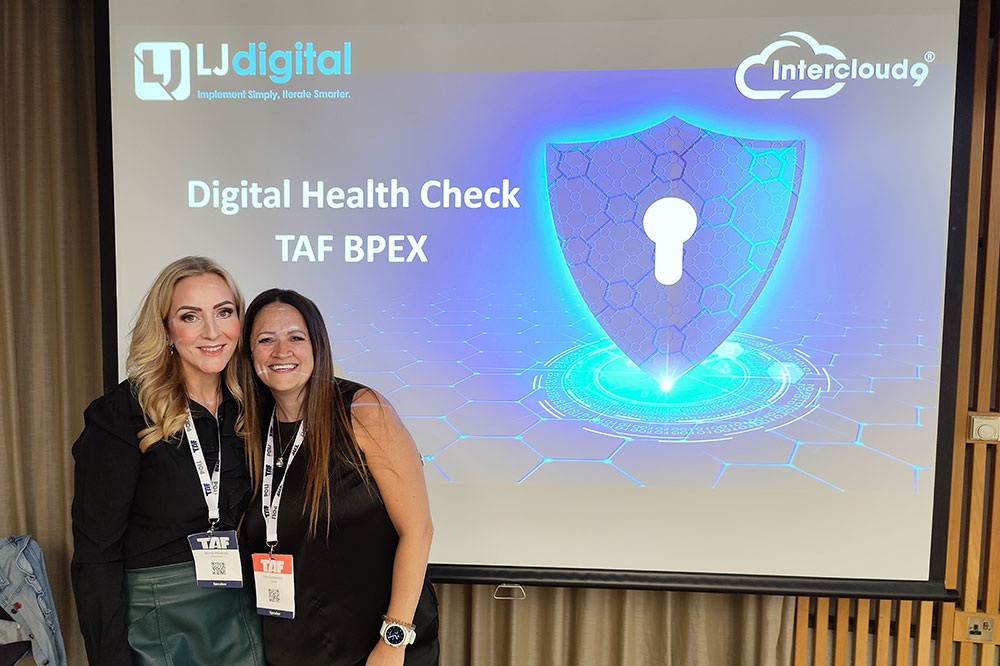Lessons from TAF Best Practice Exchange.
At the recent Trade Association Forum (TAF) Best Practice Exchange, Jen Watkins of Intercloud9 was delighted to co-present with Lisa Goldsmith of LJ Digital on the state of digital maturity across associations and professional bodies.
Our session combined practical frameworks with a live survey of attendees’ own organisations, providing an honest snapshot of where the sector stands today. The results were telling – and they shed light on both the opportunities and the barriers facing membership leaders as they navigate transformation.
Digital transformation remains a pressing challenge for the membership sector. Many organisations have invested heavily in technology, but the real test lies not in the systems themselves, but in whether they deliver meaningful, sustainable value for members.
Digital Transformation vs Digital Maturity
We began by clarifying two terms that are often used interchangeably, but which represent very different things:
- Digital transformation is the what: the intentional redesign of how an organisation creates value through technology, data, and new ways of working.
- Digital maturity is the how: the organisation’s ability to embed these changes across people, culture, processes, and technology to deliver member value confidently and sustainably.
In other words, digital transformation can be a project or initiative, but digital maturity is an organisational capability. Without maturity, technology investments risk becoming siloed or underused.
Why Does Digital Transformation Matter?
We opened the session by asking delegates a simple but powerful question: Why does digital transformation matter to you?
The live word cloud was revealing. The most common responses clustered around themes of growth, efficiency, productivity, engagement, and resilience. Leaders highlighted the need to keep things current, deliver better member experiences, support innovation, and future-proof their organisations.
Other terms captured the realities of day-to-day pressures: improved workflow, automation, analytics, speed, accessibility, reputation, investment, relevance, and value for money. Some were more cautious, noting the risks of projects being seen as the “latest buzzword” or “expensive”.
This snapshot illustrates the diversity of motivations within the sector. For some, transformation is about operational efficiency; for others, it is about enhancing member journeys or ensuring long-term sustainability. The common thread is clear: digital matters because it underpins both resilience and relevance in an increasingly competitive environment.
Understanding the Digital Maturity Model
To make sense of the survey results, it helps to understand the maturity model we used. This five-stage framework describes the journey from ad hoc digital activity to fully optimised digital capability:
1. Nascent
- Digital is ad hoc and tactical, with limited vision or coordination.
- Common signs: siloed data, legacy systems, manual rekeying, projects that struggle to land.
2. Exploring
- Teams are piloting digital ideas, but activity is fragmented and unscaled.
- Signs: isolated trials, early analytics, basic journey mapping, uneven governance.
3. Developing
- Digital has a funded plan with repeatable methods and visible improvements.
- Signs: joined-up journeys in key areas, initial integrations, targeted automation, growing skills.
4. Integrated
- Digital is embedded across functions with shared goals and end-to-end delivery.
- Signs: reliable platforms, API integrations, single reporting layer, continuous improvement cycles.
5. Optimised
- Digital drives strategy and value creation, with continuous learning and innovation.
- Signs: data-driven decisions, modular architecture, pervasive automation, responsible AI, strong outcomes on member satisfaction, growth, and cost efficiency.
By mapping their scores to this model, organisations can identify not only where they are today, but also the next steps needed to progress. The live results placed most attendees between Exploring and Developing – evidence that the sector is moving forward but still has work to do to embed maturity fully.
Live Digital Maturity Results
To move beyond theory, we asked attendees to complete a short live assessment, rating their organisations across six areas of digital maturity. The results provide a useful sector benchmark.
Category and Average Score
- Strategy and leadership: 2.6
- Member / customer experience: 3.3
- Data and insight: 2.7
- Technology and platforms:3.0
- Processes and automation: 2.4
- People, skills and culture: 3.1
- Overall Digital Maturity Score: 2.9
On our maturity model, this places the cohort in the transition between ‘Exploring’ and ‘Developing’. Strengths included member experience, technology adoption, and supportive culture, while weaknesses lay in processes, automation, and data insights. Strategy and leadership also emerged as a critical pinch point.
Common Barriers to Transformation
Our presentation explored why so many transformation programmes fail, drawing on both sector evidence and wider research. The barriers can be grouped into four main pitfalls:
- The Wrong Focus – Technology projects seen as ends in themselves rather than enablers of member value.
- The Wrong Change Approach – Change treated as a one-off project rather than a cultural shift.
- The Wrong Resourcing – Underestimation of capacity and specialist skills needed to deliver change.
- The Wrong Alignment – Strategic goals, operational plans, and technology projects not sufficiently joined up.
A Framework for Digital Success
To address these pitfalls, we set out a practical framework – a roadmap that membership organisations can adapt:
- The Right Focus – Define purpose, member outcomes, and position technology as an enabler.
- The Right Change – Put members at the centre, empower staff, and create a culture of self-sufficiency.
- The Right Resources – Identify skills gaps and supplement capability strategically.
- The Right Alignment – Link strategy, actions, and outcomes with a clear target operating model.
Conclusion
The conversations at TAF Best Practice Exchange reaffirmed what many of us already know: the membership sector is full of energy, creativity, and ambition. But digital transformation is not easy. Success depends on clarity of purpose, cultural alignment, and the courage to invest in the less visible foundations that underpin maturity.
As our live survey showed, the sector is progressing – but there is still work to do to move from exploring to integrated and ultimately optimised maturity.
We concluded by launching The Leadership Blueprint, a sector-first leadership skills programme designed specifically for senior leaders of membership and non-profit organisations. You can find more information about the programme here.
Thank you to all who contributed to the discussion, and to my co-presenter Lisa Goldsmith of LJ Digital for her insights and expertise.



